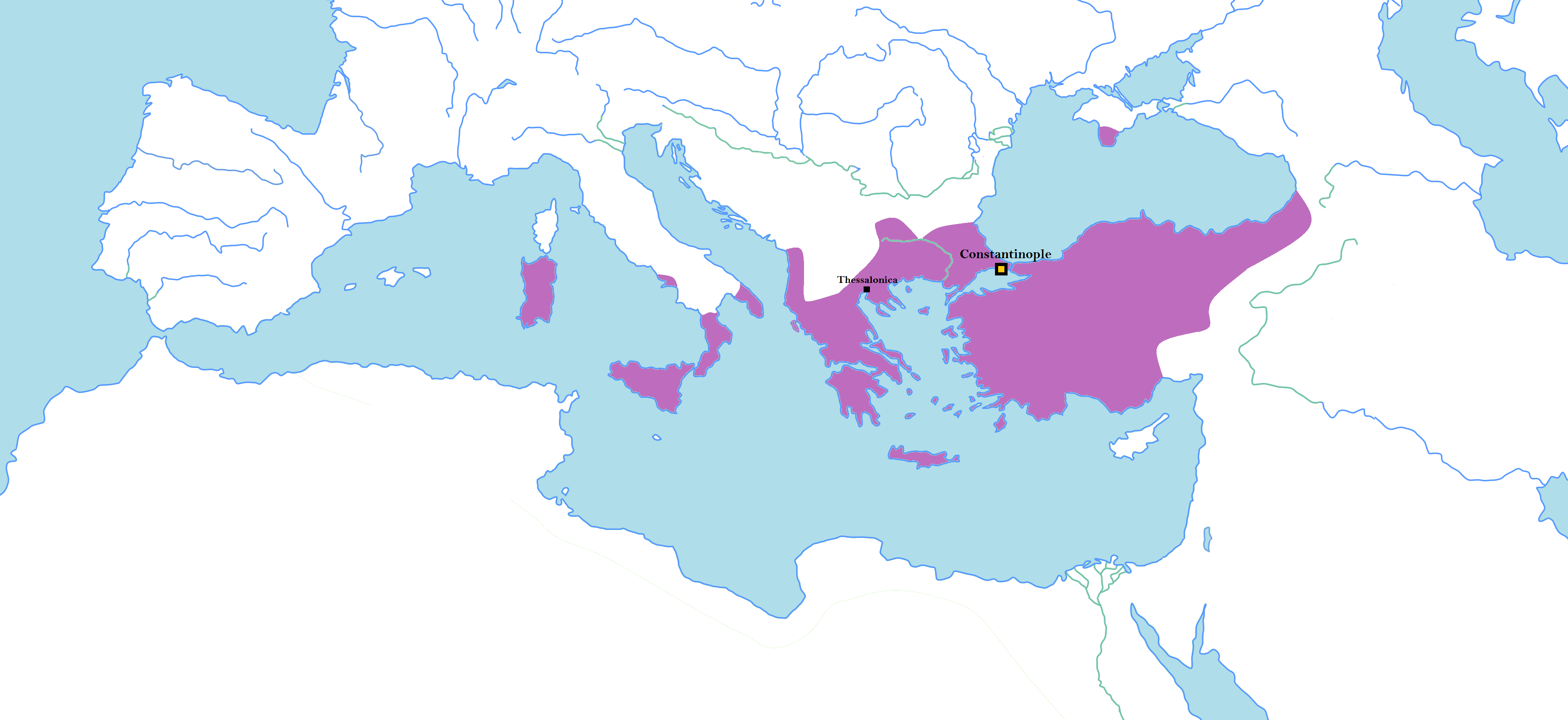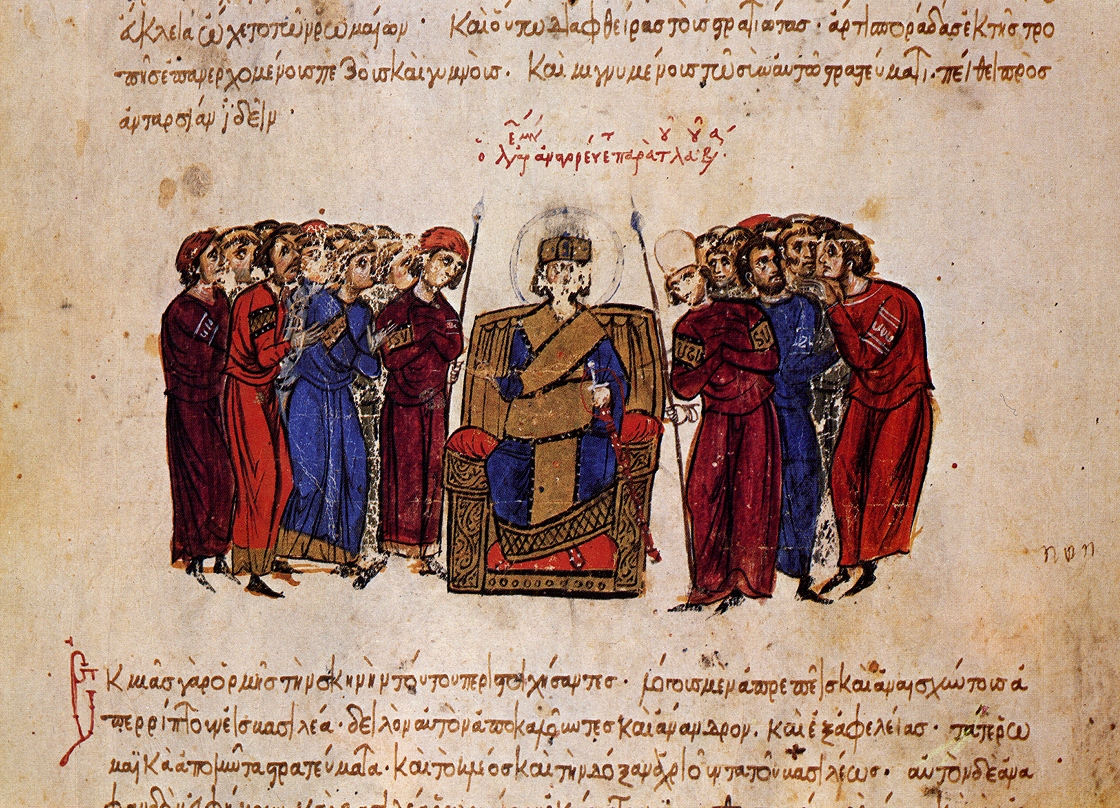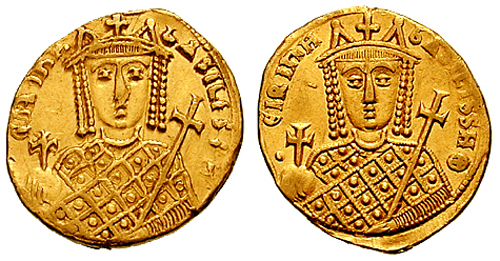|
Nikephoros I Logothetes
Nikephoros I or Nicephorus I ( gr, Νικηφόρος; 750 – 26 July 811) was Byzantine emperor from 802 to 811. Having served Empress Irene as '' genikos logothetēs'', he subsequently ousted her from power and took the throne himself. In reference to his career before becoming emperor, he is sometimes surnamed "the Logothete" (ὁ Λογοθέτης) and "Genikos" or "Genicus" (ὁ Γενικός). Nikephoros pursued wars against the Arabs and Bulgarians, with mixed results; while invading Bulgaria he was defeated and killed at the Battle of Pliska. Background Sources outside the Byzantine context, including Michael the Syrian, al-Tabari, and Mas'udi, preserve the tradition that Nikephoros was of Ghassanid Arab origin. al-Tabari claims that he derived this information from Byzantine sources, but no surviving Byzantine chronicle makes explicit mention of the emperor's ethnic background. The modern scholar Paul Julius Alexander suggests that al-Tabari did transmit informatio ... [...More Info...] [...Related Items...] OR: [Wikipedia] [Google] [Baidu] |
List Of Byzantine Emperors
This is a list of the Byzantine emperors from the foundation of Constantinople in 330 AD, which marks the conventional start of the Eastern Roman Empire, to its fall to the Ottoman Empire in 1453 AD. Only the emperors who were recognized as legitimate rulers and exercised sovereign authority are included, to the exclusion of junior co-emperors (''symbasileis'') who never attained the status of sole or senior ruler, as well as of the various usurpers or rebels who claimed the imperial title. The following list starts with Constantine the Great, the first Christian emperor, who rebuilt the city of Byzantium as an imperial capital, Constantinople, and who was regarded by the later emperors as the model ruler. It was under Constantine that the major characteristics of what is considered the Byzantine state emerged: a Roman polity centered at Constantinople and culturally dominated by the Greek East, with Christianity as the state religion. The Byzantine Empire was the direct lega ... [...More Info...] [...Related Items...] OR: [Wikipedia] [Google] [Baidu] |
Patrikios
The patricians (from la, patricius, Greek: πατρίκιος) were originally a group of ruling class families in ancient Rome. The distinction was highly significant in the Roman Kingdom, and the early Republic, but its relevance waned after the Conflict of the Orders (494 BC to 287 BC). By the time of the late Republic and Empire, membership in the patriciate was of only nominal significance. The social structure of Ancient Rome revolved around the distinction between the patricians and the plebeians. The status of patricians gave them more political power than the plebeians. The relationship between the patricians and the plebeians eventually caused the Conflict of the Orders. This time period resulted in changing the social structure of Ancient Rome. After the Western Empire fell, the term "patrician" continued as a high honorary title in the Eastern Empire. In the Holy Roman Empire and in many medieval Italian republics, medieval patrician classes were once again formal ... [...More Info...] [...Related Items...] OR: [Wikipedia] [Google] [Baidu] |
Iconodule
Iconodulism (also iconoduly or iconodulia) designates the religious service to icons (kissing and honourable veneration, incense, and candlelight). The term comes from Neoclassical Greek εἰκονόδουλος (''eikonodoulos'') (from el, εἰκόνα – ''icon (image)'' + el, δοῦλος – ''servant''), meaning "one who serves images (icons)". It is also referred to as iconophilism (also iconophily or iconophilia from el, εἰκόνα – ''icon (image)'' + el, φιλέω – ''love'') designating a positive attitude towards the religious use of icons. In the history of Christianity, iconodulism (or iconophilism) was manifested as a moderate position, between two extremes: iconoclasm (radical opposition to the use of icons) and iconolatry (idolatric veritable (full) adoration of icons). History In contrast to moderate or respectful adoration, various forms of latria of icons (''iconolatry'') were also starting to appear, mainly in popular worship. Since verita ... [...More Info...] [...Related Items...] OR: [Wikipedia] [Google] [Baidu] |
Arsaber
Arsaber ( el, , from Armenian ''Arshavir''), was a Byzantine noble who attempted an unsuccessful usurpation of the Byzantine imperial throne in 808. Biography Arsaber was a noble of Armenian origin, holding the rank of ''patrikios'', and served as ''quaestor'' of Emperor Nikephoros I Logothetes (r. 802–811). In February 808, a group of secular and ecclesiastic officials, who were dissatisfied with Nikephoros's rule, formed a conspiracy and acclaimed Arsaber as emperor... Nikephoros, however, discovered the plot and arrested the participants, who were beaten, had their properties confiscated, and were ultimately exiled. Arsaber himself was tonsured and exiled to a monastery in Bithynia. Arsaber's daughter, Theodosia, had been married to the future Emperor Leo V the Armenian Leo V the Armenian ( gr, Λέων ὁ ἐξ Ἀρμενίας, ''Leōn ho ex Armenias''; 775 – 25 December 820) was the Byzantine emperor from 813 to 820. A senior general, he forced his predecessor, Mich ... [...More Info...] [...Related Items...] OR: [Wikipedia] [Google] [Baidu] |
Monastery
A monastery is a building or complex of buildings comprising the domestic quarters and workplaces of monastics, monks or nuns, whether living in communities or alone (hermits). A monastery generally includes a place reserved for prayer which may be a chapel, church, or temple, and may also serve as an oratory, or in the case of communities anything from a single building housing only one senior and two or three junior monks or nuns, to vast complexes and estates housing tens or hundreds. A monastery complex typically comprises a number of buildings which include a church, dormitory, cloister, refectory, library, balneary and infirmary, and outlying granges. Depending on the location, the monastic order and the occupation of its inhabitants, the complex may also include a wide range of buildings that facilitate self-sufficiency and service to the community. These may include a hospice, a school, and a range of agricultural and manufacturing buildings such as a barn, a fo ... [...More Info...] [...Related Items...] OR: [Wikipedia] [Google] [Baidu] |
Michael II
Michael II ( gr, Μιχαὴλ, , translit=Michaēl; 770–829), called the Amorian ( gr, ὁ ἐξ Ἀμορίου, ho ex Amoríou) and the Stammerer (, ''ho Travlós'' or , ''ho Psellós''), reigned as Byzantine Emperor from 25 December 820 to his death on 2 October 829, the first ruler of the Amorian dynasty. Born in Amorium, Michael was a soldier, rising to high rank along with his colleague Leo V the Armenian ( 813–820). He helped Leo overthrow and take the place of Emperor Michael I Rangabe. However, after they fell out Leo sentenced Michael to death. Michael then masterminded a conspiracy which resulted in Leo's assassination at Christmas in 820. Immediately he faced the long revolt of Thomas the Slav, which almost cost him his throne and was not completely quelled until spring 824. The later years of his reign were marked by two major military disasters that had long-term effects: the beginning of the Muslim conquest of Sicily, and the loss of Crete to the Saracens. Do ... [...More Info...] [...Related Items...] OR: [Wikipedia] [Google] [Baidu] |
Leo V The Armenian
Leo V the Armenian ( gr, Λέων ὁ ἐξ Ἀρμενίας, ''Leōn ho ex Armenias''; 775 – 25 December 820) was the Byzantine emperor from 813 to 820. A senior general, he forced his predecessor, Michael I Rangabe, to abdicate and assumed the throne. He ended the decade-long war with the Bulgars, and initiated the second period of Byzantine Iconoclasm. He was assassinated by supporters of Michael the Amorian, one of his most trusted generals, who succeeded him on the throne. Life Leo was the son of the patrician Bardas, who was of Armenian descent (according to Theophanes Continuatus, Leo was also of Assyrian that is Syrian descent). Leo served in 803 under the rebel general Bardanes Tourkos, whom he deserted in favor of Emperor Nikephoros I. The Emperor rewarded Leo with two palaces, but later exiled him for marrying the daughter of another rebel, the patrician Arsaber. On the other hand, a contemporary source says that one general Leo of the Armeniakon theme was punish ... [...More Info...] [...Related Items...] OR: [Wikipedia] [Google] [Baidu] |
Bardanes Tourkos
Bardanes, nicknamed ''Tourkos'', "the Turk" ( gr, Βαρδάνης ὁ Τοῦρκος, Bardanēs ho Tourkos, ), was a Byzantine general of Armenian origin who launched an unsuccessful rebellion against Emperor Nikephoros I () in 803. Although a major supporter of Byzantine empress Irene of Athens (), soon after her overthrow he was appointed by Nikephoros as commander-in-chief of the Anatolian armies. From this position, he launched a revolt in July 803, probably in opposition to Nikephoros's economic and religious policies. His troops marched towards Constantinople, but failed to win popular support. At this point, some of his major supporters deserted him and, reluctant to engage the loyalist forces in battle, Bardanes gave up and chose to surrender himself. He retired as a monk to a monastery he had founded. There he was blinded, possibly on Nikephoros's orders. Origin and early career Nothing is known of the early life of Bardanes. He is usually regarded by modern scholars a ... [...More Info...] [...Related Items...] OR: [Wikipedia] [Google] [Baidu] |
Synopsis Chronike (Skoutariotes)
The ''Synopsis Chronike'' ( el, Σύνοψις Χρονικὴ) is a 13th-century universal chronicle, from the Creation until the recapture of Constantinople by the Greeks in 1261. A. Heisenberg has shown it was written by the Bishop of Cyzicus, Theodore Skoutariotes, and this identification has been generally accepted since. The chronicle comprises two parts, the first, ranging from the Creation to the accession of Alexios I Komnenos in 1081, being a typical chronicle, while the second, from 1081 to 1261, is a detailed historical account. A portion of the second part consists of excerpts from Niketas Choniates and George Akropolites, but the material derived from Akropolites includes much additional information, which George Ostrogorsky wrote "give the chronicle its real value as a source."Ostrogorsky, ''History of the Byzantine State'', translated by Joan Hussey (New Brunswick: Rutgers University Press, 1957), p. 371 The chronicle was first edited and published by the Greek sch ... [...More Info...] [...Related Items...] OR: [Wikipedia] [Google] [Baidu] |
Theophanes Continuatus
''Theophanes Continuatus'' ( el, συνεχισταί Θεοφάνους) or ''Scriptores post Theophanem'' (, "those after Theophanes") is the Latin name commonly applied to a collection of historical writings preserved in the 11th-century Vat. gr. 167 manuscript.Kazhdan (1991), p. 2061 Its name derives from its role as the continuation, covering the years 813–961, of the chronicle of Theophanes the Confessor, which reaches from 285 to 813. The manuscript consists of four distinct works, in style and form very unlike the annalistic approach of Theophanes.Kazhdan (1991), pp. 2061–2062 The first work, of four books consists of a series of biographies of the emperors reigning from 813 to 867 (from Leo the Armenian to Michael III). As they were commissioned by Emperor Constantine VII (r. 913–959), they reflect the point of view of the reigning Macedonian dynasty. The unknown author probably used the same sources as Genesios. The second work is known as the ''Vita Basilii'' (La ... [...More Info...] [...Related Items...] OR: [Wikipedia] [Google] [Baidu] |
Anatolia
Anatolia, tr, Anadolu Yarımadası), and the Anatolian plateau, also known as Asia Minor, is a large peninsula in Western Asia and the westernmost protrusion of the Asian continent. It constitutes the major part of modern-day Turkey. The region is bounded by the Turkish Straits to the northwest, the Black Sea to the north, the Armenian Highlands to the east, the Mediterranean Sea to the south, and the Aegean Sea to the west. The Sea of Marmara forms a connection between the Black and Aegean seas through the Bosporus and Dardanelles straits and separates Anatolia from Thrace on the Balkan peninsula of Southeast Europe. The eastern border of Anatolia has been held to be a line between the Gulf of Alexandretta and the Black Sea, bounded by the Armenian Highlands to the east and Mesopotamia to the southeast. By this definition Anatolia comprises approximately the western two-thirds of the Asian part of Turkey. Today, Anatolia is sometimes considered to be synonymous with Asian ... [...More Info...] [...Related Items...] OR: [Wikipedia] [Google] [Baidu] |
Balkans
The Balkans ( ), also known as the Balkan Peninsula, is a geographical area in southeastern Europe with various geographical and historical definitions. The region takes its name from the Balkan Mountains that stretch throughout the whole of Bulgaria. The Balkan Peninsula is bordered by the Adriatic Sea in the northwest, the Ionian Sea in the southwest, the Aegean Sea in the south, the Turkish Straits in the east, and the Black Sea in the northeast. The northern border of the peninsula is variously defined. The highest point of the Balkans is Mount Musala, , in the Rila mountain range, Bulgaria. The concept of the Balkan Peninsula was created by the German geographer August Zeune in 1808, who mistakenly considered the Balkan Mountains the dominant mountain system of Southeast Europe spanning from the Adriatic Sea to the Black Sea. The term ''Balkan Peninsula'' was a synonym for Rumelia in the 19th century, the European provinces of the Ottoman Empire. It had a ge ... [...More Info...] [...Related Items...] OR: [Wikipedia] [Google] [Baidu] |








